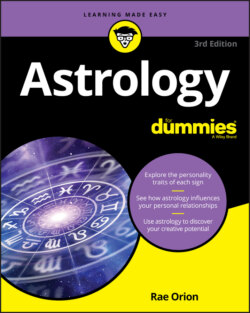Читать книгу Astrology For Dummies - Rae Orion - Страница 13
THE SIGNS, THE CONSTELLATIONS, AND THE PRECESSION OF THE EQUINOXES
ОглавлениеThousands of years ago, when the Babylonians were establishing the principles of astrology, the constellations and the signs of the zodiac were roughly in alignment. On the vernal equinox (the first day of spring), the Sun was “in” the constellation Aries. That is, if you could observe the Sun and the stars simultaneously, you’d see the Sun amidst the stars of the Ram. In those happy days, known as the Age of Aries, the signs and the constellations more or less coincided.
Alas, this is no longer the case. On the vernal equinox today, the Sun appears amidst the (dim) stars of Pisces the Fish — a very different kettle indeed. The reason for this shift is that the Earth is not a perfect sphere. It’s fatter around the middle, and its mass is distributed unequally. So it wobbles on its axis, which traces a circle in space like the spindle of a spinning top. As the Earth revolves around the Sun, the axis gradually shifts its orientation. Over the years, the constellations seem to slip backwards, a phenomenon first identified by the Greek astronomer Hipparchus in the second century BCE. The amount of slippage over a lifetime is minuscule — about one degree every 72 years — but over generations it adds up. Every equinox takes place slightly earlier in the zodiac than the one before. This process is called the precession of the equinoxes. It explains why the vernal equinox, which used to occur in the constellation Aries, now technically takes place in Pisces. It also explains why the signs and the constellations are no longer aligned.
One of these days, the equinox will slip back even further, to the constellation of the Water Bearer, and the Age of Aquarius will officially begin. Astrologers differ as to when that will happen because it depends on how you measure the constellations. If only they were neater! If only they were the same size! Instead, they bump into each other and overlap, and their boundaries are a matter of opinion. Do you use the artificial, right-angled, patchwork-like borders assigned to each constellation by the International Astronomical Union in 1930? Or do you look to the ecliptic, which has been artificially divided into 12 equal sections, one per sign? A Belgian astronomer, using the IAU measurements, suggests that the Age of Aquarius will begin in 2597. Another Belgian, writing in February 1890, announced that the Age of Aquarius would begin the very next month. 1844 has been nominated, along with 1962, 2012, and 3573. I cast with my vote with the English astronomer Nicholas Campion, who believes that the Age of Aquarius will begin — or has begun — between 1447 and 3596. Sounds right to me.
In short, there is no agreement except on this one point: Eventually, the equinox point will cycle backwards through the zodiac, all the way to Aries. That process takes about 25,800 years and is known as the Great Year. Our current Great Year began around 2000 BCE. Around the year 23800, the next one will begin. The vernal equinox will return to Aries. The constellations and the divisions of the ecliptic will align, and astrologers will be able to skip this entire explanation. Meanwhile, the constellations and the signs of the zodiac are not the same.
Skeptics who attack astrology — and for some reason, these wary souls can be amazingly hostile — often point to the changing position of the constellations and the precession of the equinoxes as proof that astrology is bogus. The truth is that astrologers are well aware of this phenomenon. In western astrology, the constellations are signposts or symbols. What matters is the division of the ecliptic. The stars, glorious though they are, have nothing to do with your sign.
For that reason, I avoid the term “star sign.” It’s an enchanting phrase, and I wish I could use it in good conscience. I don’t because it misrepresents astrology as it is usually practiced. I prefer the accuracy and simplicity of “Sun sign,” and that is the phrase I use in this book.
